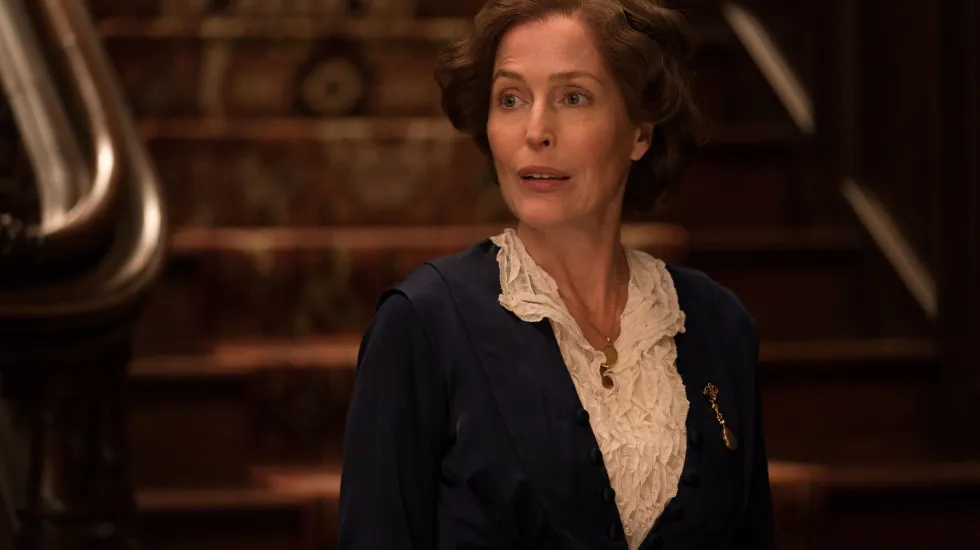
In the second episode of the ambitious and sprawling but disappointingly flat and rote Showtime limited series “The First Lady,” Michelle Pfeiffer’s Betty Ford watches television in August of 1974 as we see news footage of President Richard Nixon announcing, “I shall resign the presidency, effective at noon tomorrow.”
To be clear: the fictional Betty Ford is watching the real-life Richard Nixon on the TV in this scene. A moment later, though, when Betty and her husband Gerald Ford (Aaron Eckhart) are in attendance as Nixon exits the White House, actor Paul Wilson is portraying the outgoing president. It’s a small glitch but nonetheless jarring; why didn’t they just film a scene with Wilson as Nixon addressing the nation, for the sake of dramatic consistency and continuity?
8 p.m. Sundays on Showtime beginning this weekend.
This is an admittedly minor yet telling moment in this 10-part series, which was created by Aaron Cooley, with the gifted Susan Bier (“The Night Manager,” “The Undoing”) directing every episode. Covering more than a century of American history as filtered through the experiences of first ladies Eleanor Roosevelt (Gillian Anderson), Betty Ford (Michelle Pfeiffer) and Michelle Obama (Viola Davis), “The First Lady” has the blue-ribbon credentials of a prestige, awards-contender series. But the writing is often clunky, obvious and filled with Big Picture Messaging, too many of the supporting characters are one-note caricatures, and at the end of this well-intentioned marathon, it feels as if we’ve being reading Wikipedia entries all day long. (No offense to Wikipedia, but that does NOT make for an immersive and enlightening viewing experience.)
Nearly every biopic or limited dramatic series we see these days employs the technique of hopping back and forth along the timeline—sometimes to powerful dramatic effect, as events from the past inform what transpires in the present, but sometimes to the point of dizzying distraction.

Unfortunately, the latter is often the case with “The First Lady,” which features scenes set in 2008, then 2006, then 1973, 1921, 1982, 1933, back to 1981, 1974, 1947, 1900, 2001, 1940, 2016; rinse and repeat. With the first-rate production values establishing the time period and the fine performances from the three leads, we’re often just getting settled into a dramatic arc when the story whiplashes back some 50 years, then forward 20 years, then all the way back to the 19th century.
Musical cues such as “Louie, Louie,” “I Shot the Sheriff” and “Begin the Beguine” and distinctive visual hues represent the respective eras (warm, autumnal colors for Eleanor’s story, the obligatory golden-hued look for the 1970s, and a crisp, hi-definition vibe for the 21st century scenes), so it’s not as if we can possibly be lost as to where we are; it would just be nice if they allowed the various timelines to breathe.
“The First Lady” establishes its main theme early and hammers it home throughout: that each of these admirable, accomplished, pioneering women refused to be relegated to the traditional “supportive wife” role in the White House and had to overcome a myriad of obstacles and opposition to be seen and heard. Eleanor Roosevelt has zero patience for teas and dinners and decorating, and becomes an important voice through her radio addresses, speeches and newspaper column. Betty Ford is considered a liability by Nixon’s leftover staff but forges her own path, even as she battles alcoholism and an addiction to painkillers. Michelle Obama is determined to make a difference and have a voice beyond establishing the White House vegetable garden.

Michelle Pfeiffer delivers the most impressive and layered performance in the series as Betty Ford, first seen mixing a strong drink in the middle of the day and dancing to Nilsson’s “Coconut” in 1973, a time when her husband Gerald (Aaron Eckhart, doing fine work) was a congressman contemplating retirement.
Gillian Anderson makes for an impressive Eleanor Roosevelt, though the character is often made to issue proclamations as if she’s in a Disney World production about “America’s Greatest First Ladies.”
As for Kiefer Sutherland’s Franklin Delano Roosevelt: the performance falls somewhere between the all-time great FDR portrayals by the likes of Ralph Bellamy and the cartoonishly ridiculous performance by Jon Voight in “Pearl Harbor.” O.T. Fagbenle does a pretty fair Barack Obama impersonation, but as written, Barack comes across as slick, wisecracking and relatively shallow—like a sitcom husband forever asking for his wife’s forgiveness or approval.
Younger actors portray the future first ladies and presidents during their courtship periods, and the dialogue often feels as if it’s written directly for the audience as opposed to coming across as naturally conversational, e.g., when Jake Picking as young Gerald Ford meets Kristine Forseth as young Betty Ford:
Gerald: “It’s Gerald. Gerald Ford.”
Betty: “I’d have to live in a cave not to know the football star of the Grand Rapids South High Wolverines.”
And… scene.
There are moments when “The First Lady” is inspirational and moving; how could you not tell these stories without hitting some high notes? Still, given the credentials and talents of the behind-the-scenes artists and the three leads, this feels mostly like a missed opportunity to do something special—something worthy of Eleanor Roosevelt, Betty Ford and Michelle Obama, three truly great Americans.







